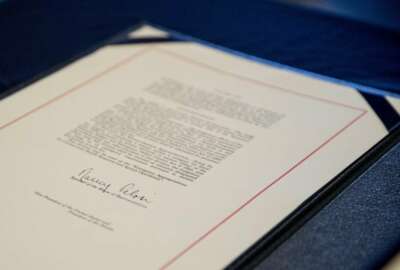

The Economic Development Administration has given out more than a billion dollars in grant money under the CARES Act, and it gets another three billion under the...
Best listening experience is on Chrome, Firefox or Safari. Subscribe to Federal Drive’s daily audio interviews on Apple Podcasts or PodcastOne.
This agency has given out more than a billion dollars in grant money under the CARES Act passed last year. And it gets another three billion under the American Rescue Plan. If you’re thinking Small Business Administration — think again. It’s the Economic Development Administration. Federal Drive with Tom Temin talked about pandemic relief with the Deputy Assistant Commerce Secretary for Economic Development and the Chief Operating Officer of the EDA, Dennis Alvord.
Interview transcript:
Dennis Alvord: The statute, the CARES Act when it was passed and the specific authorities granted, EDA directed us to use our most flexible grant program, a program called the Economic Adjustment Assistance Program, to prevent, prepare for and respond to the coronavirus and the economic impacts of the pandemic. And that flexible grant authority allows us to do a wide variety of different activities to assist communities with economic development and recovery from the economic impacts of the pandemic, including things like planning and technical assistance, revolving loan funds and infrastructure development.
Tom Temin: And did the money mostly go to state and local governments, or does it go to other types of organizations?
Dennis Alvord: Eligible applicants for EDA assistance do include state and local governments, also institutions of higher education, nonprofit organizations, and others. Really, the only two categories that we don’t fund are individuals and private for profit corporations.
Tom Temin: So basically, everything the SBA does not cover is covered by the Economic Development Administration.
Dennis Alvord: Yeah, that’s largely true, I think.
Tom Temin: And these were grants? Were they loans? What were the mechanisms under which the money was distributed?
Dennis Alvord: We are a grant making organization. So we make grants to those different types of eligible entities. Although, we do have vehicles in which we can, for example, make a grant to an organization that would then establish a fund that could provide loans to other types of organizations, but our direct relationship is a grant making relationship with eligible EDA applicants.
Tom Temin: And in general, what were the criteria by which you would award a grant? Was there some process and some kind of competitive part of it or did they have to demonstrate needs in some other way?
Dennis Alvord: In the case of the CARES Act and the pandemic, because of the unusual and compelling urgency of the economic situation and the economic dislocations that were occurring, EDA took a slightly different approach than our traditional grant making approach. Generally, we have a competitive grant making process in which we solicit and review applications competitively. But in this case, we decided that it was really in the public interest for us to use a portion of those funds and get them out and working very, very quickly to respond to the sudden and severe economic impacts that had occurred. So we made a series of non competitive awards utilizing our network of existing high performing EDA grant recipients. So we made awards to economic development districts, to university centers, and to tribal planning organizations to really help support capacity building, so that they could develop plans and strategies for economic recovery within the geographic areas that they covered. We also made non competitive awards to a network of revolving loan fund operators around the country. And those investments were intended to be responsive to the capital access needs that were occurring. So that included roughly half of our portfolio of assistance. And then we did engage in a couple of different types of competitive grant making where we went out and based on levels of economic distress, based on the types of proposals that were going to be most impactful in helping areas to recover and bounce back from the pandemic, we made a variety of different types of competitive awards.
Tom Temin: And what kinds of mechanisms do you have in place now to make sure that the grants worked in the way that you expected them to work?
Dennis Alvord: Well, one of the things that I think EDA is known for is being a very customer focused and customer centric agency. And we work very closely with our grantee partners, both in terms of the grant award process and kind of guiding them through the process. But then, after the awards are made, we continue to work with them closely to provide technical assistance and oversee the implementation of those awards. So we’re continuing to engage in that process on a regular basis. We try to share best practices about things that we’re hearing that are occurring across the economic development landscape that are replicable and can be used by other communities to support their endeavors. We continue to consult with our grantee community about other resources that may be available through other federal partners that they could take advantage of to continue with the implementation of their economic development strategies and address specific needs within their communities. And we try to leverage other grantee organizations as well, such as our university center applicants and our national technical assistance applicants so that they can bring their expertise to bear and support our grantees and helping them with economic development challenges they’re confronting.
Tom Temin: And do you have signals coming back that these grants have worked in various locales to bolster economic development and economic vitality?
Dennis Alvord: We do. I think our strategy of trying to be immediately responsive and provide both some upfront capacity for planning for long term recovery, as well as providing access to capital. You may recall at the onset of the pandemic, one of the most significant needs expressed by business were capital liquidity needs, and the fact that we were able to put those dollars out and get them working very, very quickly, we’re hearing has helped a number of businesses to stay open and has helped a number of businesses to retain their workforce during this year long pandemic to date.
Tom Temin: So that’s kind of an indirect benefit, since the grants didn’t go directly to profit making businesses but it was offset by one organization, so to speak.
Dennis Alvord: Yeah, I mean, we made a grant to one of our revolving loan fund operators, and that increased the amount of capital that that operator then had available to lend to businesses. And they were able to use that to meet working capital needs and business expansion needs, even during this pandemic period. So it really was very transformative, and I think complemented some of the other types of federal assistance, you mentioned the SBA earlier, such as their Paycheck Protection Program and idle loans.
Tom Temin: And I imagine if a profit making organization somewhere locally, was able to get a loan from an EDA grantee, that might put them in a better position to get a revolving loan or some other kind of assistance from the commercial banking sector.
Dennis Alvord: Yeah, I think our hope would be that we have, like a critical gap, at a critical point in time, when they were having trouble doing exactly that. There was a dearth of funding available through the traditional commercial banking sector, we were able to step in with some products and fill that gap. And hopefully, as we bounce back and come out of the pandemic, they will be in a strong position to be able to go back to those commercial lenders and leverage their financial position to get additional assistance and continue their growth and expansion in the future.
Tom Temin: So you prime the pump, mainly.
Dennis Alvord: Exactly.
Tom Temin: And how does that billion dollars over the past year compared to what the EDA would normally grant in a given year? And if it’s much more, how were you able to staff up to get this type of work done in the time you got it done in?
Dennis Alvord: Well, that was a huge challenge indeed. Our regular program budget, last fiscal year was $333 million. So the $1.5 billion CARES Act supplemental was, what, 4.5 times that amount. So we unquestionably had to increase our staffing to successfully deploy these resources. Fortunately, Congress granted EDA a special hiring authority under the act, which allowed us to directly hire temporary employees to support rapid implementation of the funds. And to date, we’ve added, I believe, about 80 employees across the EDA enterprise. And we have a headquarters office and six regional offices that do this work, and we have a few more underway. So this hiring alone has grown the organization by about one-third in size during that timeframe. And so this was another big challenge. And remember, this entire process had to occur, virtually — the hiring, the onboarding, the training, due to the pandemic,
Tom Temin: And you’ve got another $3 billion under the American Rescue Plan, which means you’re going to need that staff for quite a while, I would think.
Dennis Alvord: We will. I expect, our workload continues to grow significantly under the American Rescue Plan, and we’ll likely have to do some additional staffing up to support the implementation of that as well.
Copyright © 2025 Federal News Network. All rights reserved. This website is not intended for users located within the European Economic Area.
Tom Temin is host of the Federal Drive and has been providing insight on federal technology and management issues for more than 30 years.
Follow @tteminWFED



